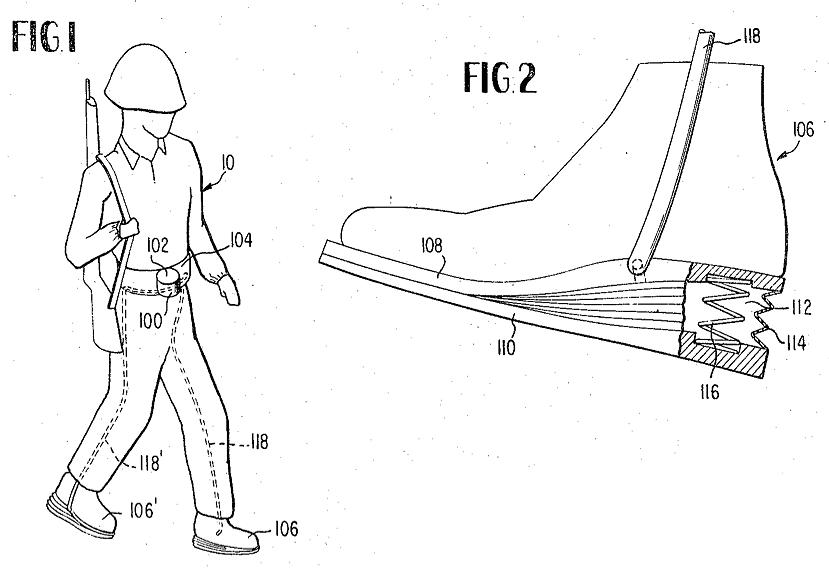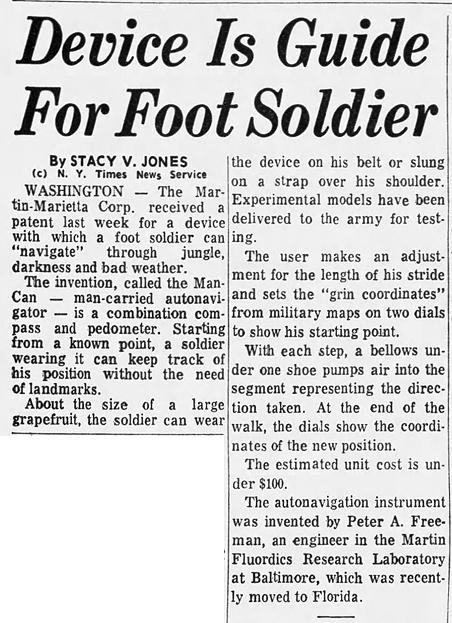The Man Can
Its formal name was the “man-carried auto-navigation device,” but it went by the nickname “Man Can.” The Martin-Marietta Corporation received patent no. 3,355,942 for it in 1967.
It was a device designed to help soldiers avoid getting lost. The patent offered this description:

It combined a compass and a pedometer. A GI would record his initial location on a map, and then the device would track his footsteps and the directions in which he turned. When he was done walking, the device would tell him his new coordinates.
A key feature of the device was that it didn't use any battery power. So the GIs would never need to worry about it running out of juice. It operated via a bellows located in the heel of the GI's shoe.
I can't find any follow-up reports about how well this gadget worked. Apparently not well enough to warrant its adoption by the army. But it was an interesting concept.

It was a device designed to help soldiers avoid getting lost. The patent offered this description:
a lightweight, completely mechanical, low energy device by which small units of men may locate themselves accurately with respect to some reference point when operating in the jungle, darkness or bad weather without dependence upon visual landmarks.

It combined a compass and a pedometer. A GI would record his initial location on a map, and then the device would track his footsteps and the directions in which he turned. When he was done walking, the device would tell him his new coordinates.
A key feature of the device was that it didn't use any battery power. So the GIs would never need to worry about it running out of juice. It operated via a bellows located in the heel of the GI's shoe.
I can't find any follow-up reports about how well this gadget worked. Apparently not well enough to warrant its adoption by the army. But it was an interesting concept.

Allentown Morning Call - Dec 11, 1967
Comments
In truth, I can't imagine it working well *at all*. The device is basically a step counter with an angle counter, but as such, it's no different from any sort of 'dead reckoning' device, which accumulates errors over time, and very quickly ends up being wildly inaccurate.
Posted by Eric Brown on 01/07/20 at 03:51 PM
I think this was one of those Proxmire's Golden Fleece projects that pop up now and then. Someone paid for the development and construction and you can be sure that Martin Corp. didn't foot the bill.
Posted by KDP on 01/07/20 at 05:59 PM
It would be a major project to create an algorithm which accurately predicted the error after an hour's use over rough terrain.
Posted by Phideaux on 01/07/20 at 07:26 PM
That actually reminds me of a situation I ran into while writing one of my fantasy books. The characters needed to be able to tell where to go, in an area with no celestial lights at all. As this was medieval fantasy, no, there were no normal compasses (plus this was a demi-plane, honestly)....so, the directions were given as an angle direction...ie, a hand's breadth toward one's right hand as a bearing to leave on.
Posted by Tiona Daughtry on 01/11/20 at 01:56 AM
Commenting is not available in this channel entry.



Category: Geography and Maps | Inventions | Patents | Military | Technology | 1960s